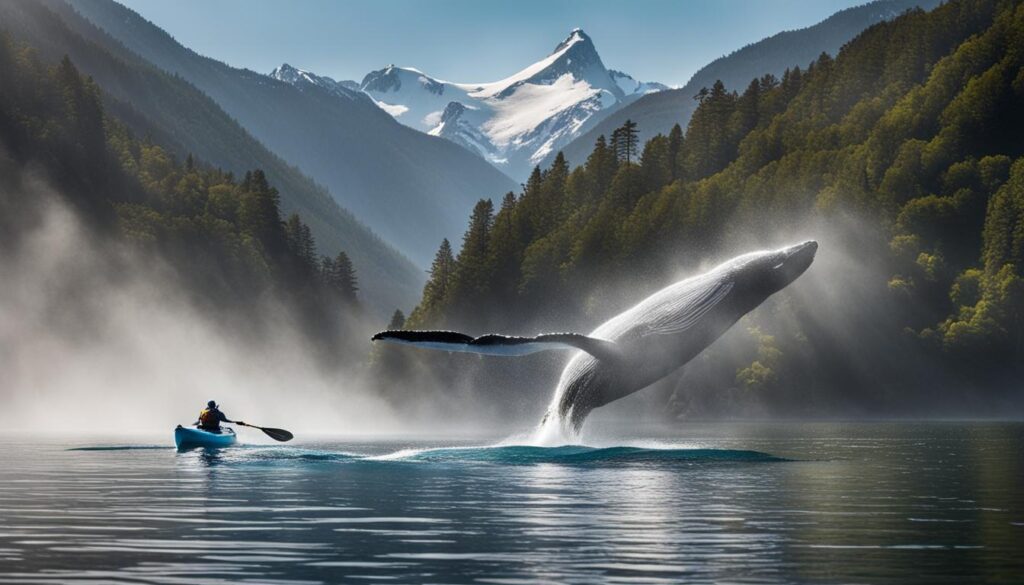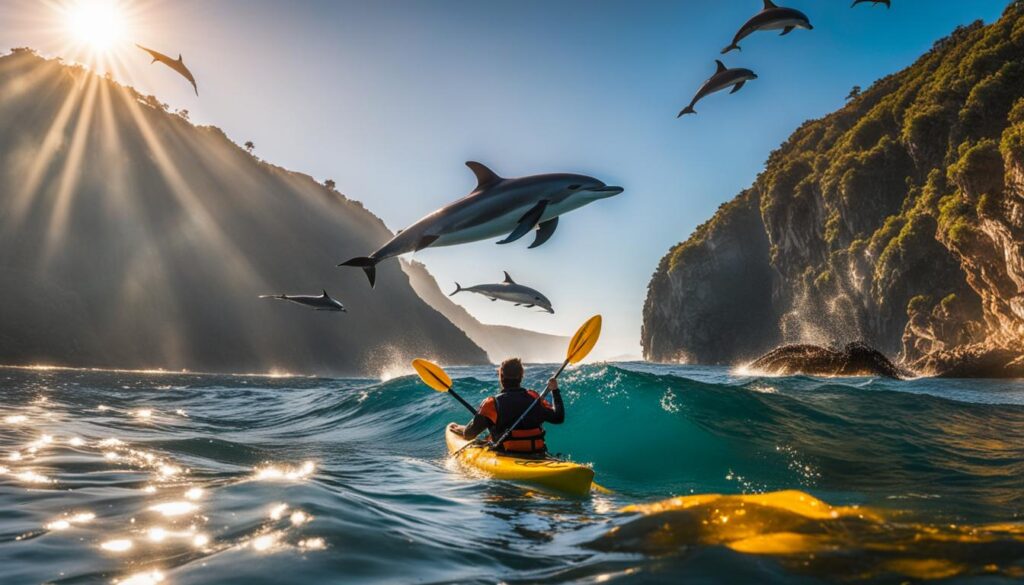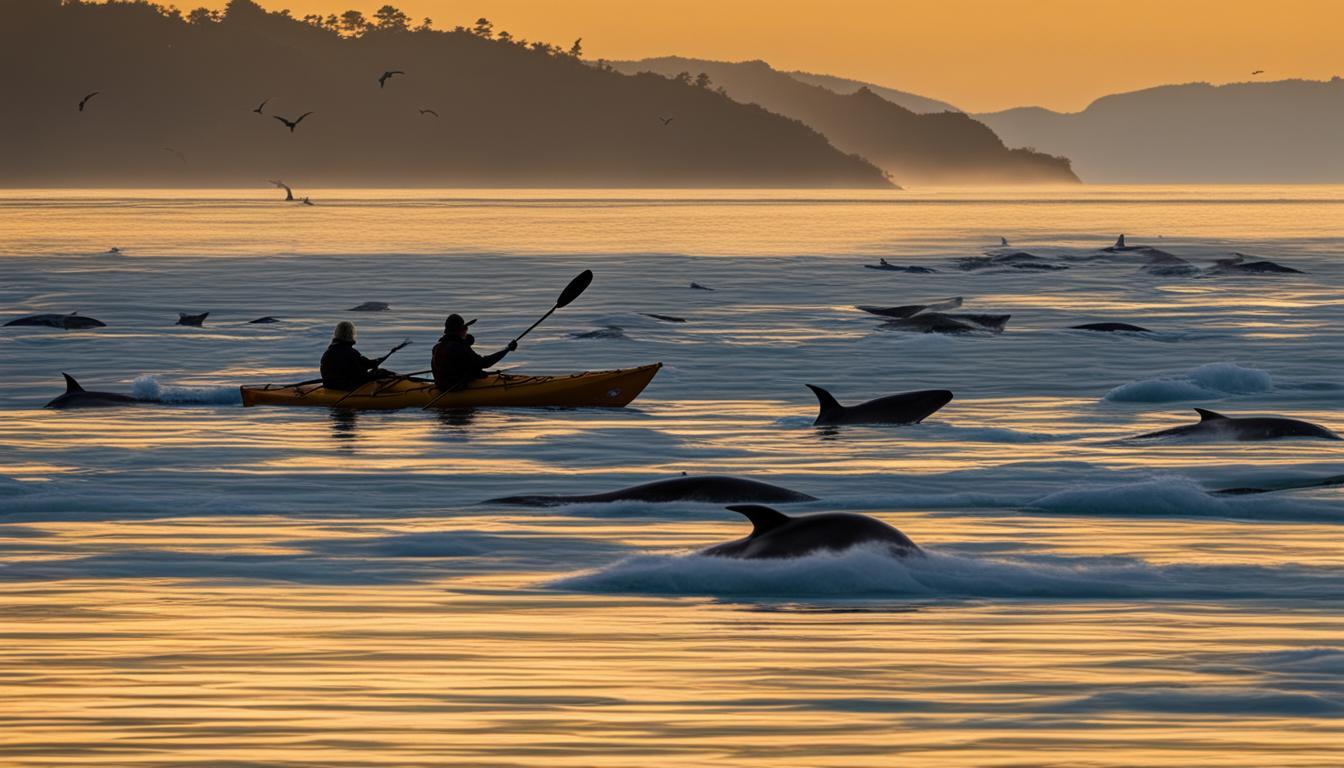When you embark on a sea kayaking adventure, be prepared for the possibility of incredible wildlife encounters. From seals and dolphins to even whales, the marine world has so much to offer. To ensure a safe and respectful experience for both you and the animals, it’s important to approach these encounters with caution and follow wildlife-friendly kayaking practices.
Understanding sea kayaking animal safety is crucial to protect the wildlife and their natural habitats. By following guidelines and maintaining a safe distance, you can enjoy the beauty of these creatures without causing any harm or disruptions.
Key Takeaways:
- Always approach wildlife encounters with respect and caution.
- Follow wildlife-friendly kayaking practices to ensure the safety of both animals and yourself.
- Maintain a safe distance and avoid chasing or surrounding marine animals.
- Be aware of laws and regulations protecting wildlife and adhere to them.
- Limit your viewing time to minimize stress on the animals’ natural habitats.
Kayaking with Orcas in Washington State
The inland waters of Washington state, specifically the Salish Sea and the San Juan Islands, offer a unique opportunity for kayakers to encounter orcas, also known as killer whales. These majestic creatures are a sight to behold, and with responsible practices, you can have a memorable and respectful wildlife experience.
Orcas are highly intelligent and social animals, and it’s important to respect their natural behavior and habitat. When kayaking near orcas, maintain a safe distance of at least 200 yards to avoid disturbing their activities. Approaching too closely or causing them to change their course can disrupt their feeding, socializing, and resting patterns.
To enhance your kayaking experience while ensuring the well-being of the orcas, consider joining a sea kayak wildlife tour led by knowledgeable guides. These tours offer valuable insights into orca behavior and conservation efforts, while providing a chance to observe these magnificent creatures in their natural environment.
“Encountering orcas while kayaking was truly a once-in-a-lifetime experience. The sight of these incredible animals gliding effortlessly through the water was awe-inspiring. It’s crucial that we all play our part in protecting their habitat and maintaining a respectful distance to ensure their continued presence for generations to come.” – Amy, avid kayaker
Orcas at a Glance
| Species | Common Name | Status |
|---|---|---|
| Orcinus orca | Killer Whale | Southern resident population is endangered |
By following these guidelines and respecting the orcas’ natural habitat, you can enjoy a safe and responsible kayaking experience while appreciating the beauty and magnificence of these incredible creatures. Remember, it is our collective responsibility to protect and preserve the marine environment for future generations.
Observing Humpback Whales on Monterey Bay
Monterey Bay in California is a haven for nature enthusiasts and sea kayakers alike. From May to October, this picturesque bay becomes a prime location for observing humpback whales during their annual migration. The sight of these majestic creatures breaching and feeding in the bay is truly awe-inspiring.
To ensure a responsible and respectful wildlife encounter while sea kayaking, it is important to adhere to guidelines and maintain a safe distance from the whales. The Monterey Bay National Marine Sanctuary recommends staying at least 100 yards away from humpback whales and not approaching them head-on or blocking their path. It is crucial to remember that we are visitors in their natural habitat and should take every measure to minimize any disturbances.
“The sight of humpback whales gracefully swimming near your kayak is a once-in-a-lifetime experience. By observing these magnificent creatures from a respectful distance, we can protect their well-being and preserve the natural wonders of Monterey Bay for generations to come,” says marine biologist Dr. Rachel Thompson.
When kayaking on Monterey Bay, it is essential to be mindful of the Code of Conduct for Whale Watching and Marine Wildlife Viewing. This code emphasizes the importance of responsible wildlife observation, including not chasing or surrounding the whales, limiting viewing time to 30 minutes or less, and avoiding any sudden movements or loud noises that may frighten or agitate the animals.
| Guidelines for Observing Humpback Whales on Monterey Bay | Do: | Don’t: |
|---|---|---|
| Maintain a safe distance of at least 100 yards from the whales. | Approach the whales from the side or behind. | Approach the whales head-on or block their path. |
| Observe the whales from a respectful distance, appreciating their natural behavior. | Chase or pursue the whales for a closer encounter. | Surround the whales with multiple kayaks. |
| Limit your viewing time to 30 minutes or less. | Make sudden movements or loud noises that may startle the whales. | Stay in the presence of the whales for an extended period. |
By following these guidelines and practicing responsible wildlife kayaking, you can enjoy the incredible experience of observing humpback whales on Monterey Bay while ensuring their safety and well-being. Let’s continue to preserve the beauty of our oceans and their inhabitants through respectful and sustainable practices.

Proximity to Wildlife in the Atlantic Coast
When embarking on a sea kayaking adventure along the Atlantic coast, you have the opportunity to encounter an array of fascinating marine life. From the gentle giants of the ocean to playful dolphins, these encounters can be truly magical. However, it is crucial to approach these encounters responsibly and respect the natural habitats of these incredible sea creatures.
Kayaking with sea creatures along the Atlantic coast can provide breathtaking experiences. One of the highlights is the chance to spot the endangered North Atlantic right whales. These majestic creatures, often seen near the surface of the water, deserve our utmost respect and care. It is important to maintain a safe distance and avoid any actions that may disturb or harass them.
Another common encounter is with dolphins, known for their playful nature and acrobatic displays. Spotting these intelligent creatures swimming and leaping alongside your kayak can be an unforgettable experience. To ensure their well-being, it is essential to give them plenty of space and refrain from approaching too closely. Remember, it’s their home, and we are merely visitors.
When venturing out along the Atlantic coast, it is important to familiarize yourself with the laws and regulations that protect marine mammals. These guidelines have been put in place to ensure the safety and conservation of these incredible creatures. By adhering to these regulations and maintaining a respectful distance, you can enjoy the beauty of encountering marine life while preserving their natural habitats.

Tips for Responsible Wildlife Encounters:
- Research the marine life in the area and familiarize yourself with their behavior and habitat preferences.
- Keep a safe distance from the animals to avoid causing stress or disturbance.
- Avoid chasing or surrounding marine animals.
- Follow local laws and regulations regarding wildlife encounters and kayaking.
- Remember that the welfare of the animals should always come first.
Encountering marine life while kayaking along the Atlantic coast is a privilege and a reminder of the incredible diversity of our oceans. By approaching these encounters with respect and following responsible wildlife-friendly practices, we can continue to enjoy these experiences while ensuring the well-being of the animals and their habitats.
| Marine Life | Encounter Details |
|---|---|
| North Atlantic Right Whale | Endangered species often seen near the surface of the water |
| Dolphins | Playful creatures known for their acrobatic displays |
| Various Fish Species | Opportunities to observe a variety of fish species in their natural habitat |
Respecting Wildlife While Sea Kayaking
When embarking on a sea kayaking adventure, encountering wildlife can be an incredible experience. However, it is crucial to approach these encounters with respect and practice responsible kayaking to ensure the safety and well-being of both the animals and yourself. By following wildlife-friendly kayaking practices, you can enjoy a memorable and ethical wildlife encounter while preserving the natural habitats of these amazing creatures.
One of the most important aspects of sea kayaking animal safety is maintaining a safe distance from the wildlife. This helps to avoid disturbing their natural behavior and minimizes the risk of any potential harm. Each species has different guidelines for the safe distance, so it is essential to familiarize yourself with the specific recommendations before heading out. By doing so, you can observe the animals from a respectful distance without causing them distress.
Another important practice is to refrain from pursuing or surrounding the animals. Instead, let them dictate the interaction while you appreciate their beauty and grace from afar. Remember, wildlife encounters are a privilege, and it’s crucial to respect the animals’ boundaries. This means not chasing them for a closer view or attempting to touch them, as this can be harmful to both the animals and their ecosystem.
Responsible wildlife encounters also involve adhering to laws and regulations that protect marine animals. These regulations are in place to safeguard their well-being and ensure their conservation for future generations. By familiarizing yourself with these guidelines, you can navigate the waters in a way that promotes the safety and preservation of the wildlife you encounter. Ultimately, by practicing responsible wildlife encounters while sea kayaking, you contribute to the protection and conservation of these magnificent creatures.
Conclusion
Encountering wildlife while sea kayaking can be a truly amazing experience. From kayaking with orcas in Washington state to observing humpback whales in Monterey Bay, these wildlife encounters provide a unique opportunity to connect with nature on a personal level.
During sea kayak wildlife tours, it is essential to prioritize respectful wildlife encounters. By following wildlife-friendly kayaking practices, you not only ensure the safety and well-being of the animals but also contribute to their conservation.
Remember to maintain a safe distance from the animals, avoiding any disruption to their natural behavior. This includes not pursuing or surrounding them. Adhering to viewing guidelines and respecting their habitats is key to having a responsible and enjoyable wildlife experience.
So, next time you embark on a sea kayaking adventure, keep in mind the importance of respectful wildlife encounters. By doing so, you can fully appreciate the beauty of these magnificent creatures while preserving their natural habitats for generations to come.
FAQ
What marine animals can I encounter while sea kayaking?
While sea kayaking, you may encounter various marine animals such as seals, dolphins, and even whales.
Where can I kayak with orcas?
Washington state, specifically the Salish Sea and the San Juan Islands, is known for being a top destination for encountering orcas.
How can I have a responsible wildlife encounter with orcas?
To have a responsible and respectful wildlife encounter with orcas, it is important to follow guidelines and maintain a safe distance from the animals to avoid disrupting their natural behavior.
Where can I observe humpback whales while kayaking?
Monterey Bay in California is a popular location for observing humpback whales during their migration.
How can I ensure a responsible wildlife encounter with humpback whales?
To ensure a responsible wildlife encounter with humpback whales, it is essential to maintain a safe distance and not chase or surround the whales.
What opportunities are there to encounter marine life along the Atlantic coast?
Along the Atlantic coast, you can encounter marine life such as endangered North Atlantic right whales and dolphins playing in pods.
How can I respect marine life while sea kayaking on the Atlantic coast?
It is important to give marine animals a wide berth, not disturb or harass them, and adhere to laws and regulations that protect marine mammals.
What practices ensure a responsible and wildlife-friendly sea kayaking experience?
Respecting wildlife and practicing responsible kayaking includes knowing the species you may encounter, understanding their behavior, and maintaining a safe distance to avoid disruptions to their natural habitats.
How can I have a safe and respectful wildlife encounter while sea kayaking?
By following wildlife-friendly kayaking practices, including following laws and regulations, limiting viewing time, and not pursuing or surrounding the animals, you can have a safe and respectful wildlife encounter while enjoying the beauty of nature from your paddle’s perspective.





